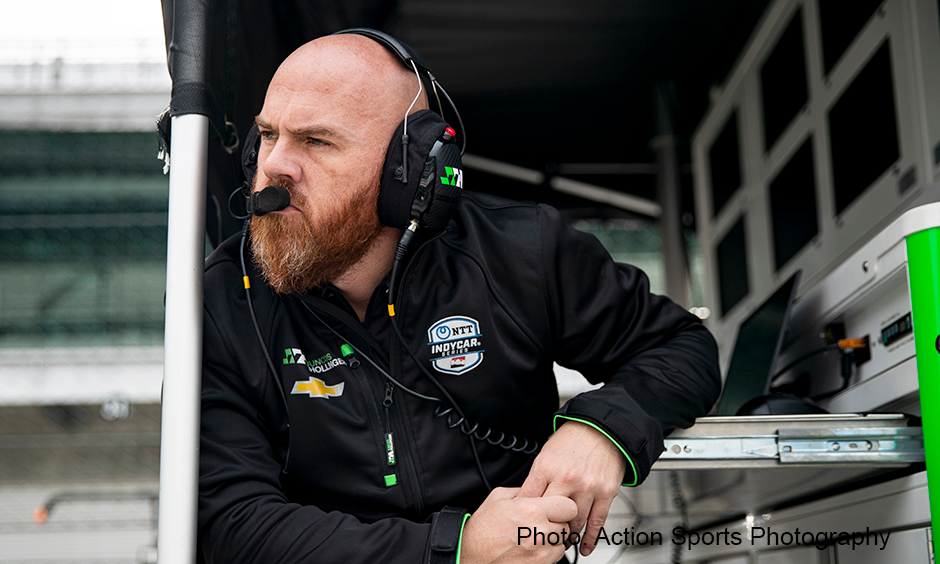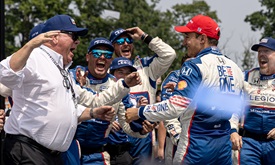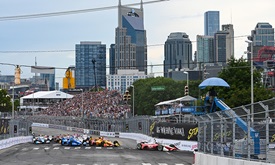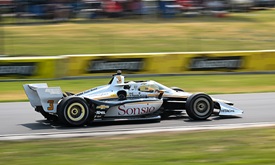The Setup: Mid-Ohio with Steve Barker
JUN 27, 2023
Note: This is a continuing series for INDYCAR.com, with different guests, leading into each race weekend for the NTT INDYCAR SERIES, focusing on various technical challenges of each respective circuit.
The ninth round of the 2023 season for the NTT INDYCAR SERIES rolls into the Buckeye State for The Honda Indy 200 at Mid-Ohio Presented by the 2023 Accord Hybrid at Mid-Ohio Sports Car Course in Lexington, Ohio, near Columbus. The 2.258-mile, 13-turn (four left, nine right) natural terrain road course features a mix of fast and flowing and tight corners, elevation changes and a narrow racing surface only 40 feet wide.
There will be two practice sessions and an NTT P1 Award qualifying bout ahead of the race day morning warmup. Coverage for the 80-lap (180.64 miles) race will begin at 1:30 p.m. ET Sunday, July 2 (USA, Peacock, INDYCAR Radio Network). The qualifying record is held by Simon Pagenaud, who threw down a flying lap of 1 minute, 3.8700 seconds in 2016.
This week’s featured guest is Steve Barker, race engineer for Callum Ilott’s No. 77 Juncos Hollinger Racing Chevrolet.
Q: What is it like preparing for Mid-Ohio Sports Car Course?
Steve Barker: The big thing when we've just come from Road America to go to Mid-Ohio, it's a completely different challenge, not least because of the track surface. We've gone from Road America that was repaved six months ago or so to Mid-Ohio that was repaved like it was about 20 years ago. It seems that long ago. The asphalt there and the different surfaces at Mid-Ohio, they're very smooth. The macro/micro level of the surface is very, very low. So, it takes a lot of work to generate tire energy. It's something that we have to look at in the setup that we take to the track. It's completely different from something that we run at Road America, for example, where it generates tire temperature more naturally or organically. Another thing is, with the specificity of Mid-Ohio itself, a lot of the corners go over crests on entries or in the middle of the corner, so we have to adapt the car and the setup to do that. For example, when we look at something like Barber (Motorsports Park), it has a lot of undulations and natural terrain the same as Mid-Ohio. However, Barber, a lot of the corners are in compressions, whereas at Mid-Ohio they're over crests. It's something that we have to really think about exactly what we want the car to do in which part of the corner and, and just kind of sets up a corner, really, because it looks the same when you look at the undulation, but the point where the car is going through a compression, or a crest is different. So, that's definitely one thing we have to approach.
Q: From a general standpoint, the smoother and flatter some tracks are, usually you can go pretty stiff on the dampers and things like that. When it comes to a place like Mid-Ohio, if you've got the bar set in the middle of neutral and you have to go stiffer or softer, which way is that place typically swayed?
Barker: For us at Mid-Ohio, we tend to run a bit stiffer. It's something where you want the car to move around as little as possible. So, the stiffer the car, the less variations in ride height you have. Whereas with the softer car the ride height moves around more. Ideally, you want to keep your aero platform as consistent as possible to give the driver as much of a consistent feeling through the whole corner. The more the car moves around, the less consistent the aero platform and the mechanical balance is going to be. It's one of those where you just want to keep the driver in a position where he's comfortable, where he gets to the 'X' part of the corner where it's the entry, the middle, or the exit and he knows what it's going to do and it's not going to have a big difference in the feeling from entry to the middle to exit. It's one of the biggest things that we have to work on getting a consistent balance for the drivers. It's a tough thing because sometimes you want the car to do a certain thing on entry, and then in the middle and then trying to isolate a change that focuses just on that one point where you're struggling can be a challenge, but that's the key. Mid-Ohio, we have to approach it in a way where we have the least amount of ride-height variations and aero variations as possible.
Q: Based on that, it sounds like Mid-Ohio is more sensitive to mechanical grip over aero grip?
Barker: Right. And to be honest, one of the biggest things with Mid-Ohio is getting a good mechanical balance while generating tire temperature. The track is so smooth the tires don't really get much heat generated into them from the roughness of the track, so we have to generate tire temp another way, which usually comes from the mechanical platform in the car. Yeah, it's more of a general tire-temp focus than it is other ways like an aero platform or whatever. It's definitely our focus, especially when you have huge migration in performance through the day with the track temp, as well, you can go from 70-degree (Fahrenheit) track temp that we'll probably have in the warmup, or something like that, to 120-degree track temp in the race. When you have a huge swing in track temp, you have to set the car up accordingly to that because you're going to take six, seven or eight laps to get a lap time out of the car in the warmup, but in the race it may be on Lap 1 or Lap 2 because the temperature in the tires is generated so quickly because the tires are already starting at such a higher temperature, as well. So, it's a lot of things like that that we have to evaluate and take into consideration when it comes to Mid-Ohio. It's more extreme than a lot of other tracks that we go to.
Q: What is the trickiest part to set up for?
Barker: I think one of the hardest parts is the entry to Turn 2, going over Turn 6, Turn 9 and then Turn 12, just because the car goes over a crest either on the entry to the corner or the exit of the corner. So, it's giving the driver confidence to place the car in the right way where it's going to react in a way that they want over the crest. When a car goes through a compression, they get more grip; and more g-forces, more grip, more downforce, basically. Whereas over a crest you just lose all the grip. So, the challenge for us is to minimize that lack of grip and the balance shift as much as possible so that we can attack the corner in the right way. That is probably the biggest challenge though those corners, in particular.
Q: The combination of fast, flowing corners but also the long straight, does that make this one of the tougher places when it comes to setting up the gearing?
Barker: We're quite lucky that we have so many options with final drives and gears that we can tune the car to pretty much whatever we need it to be. We don't really have to get too much of a compromise with gearing, really. The only compromise as far as straight-line speed would be if we had to choose between downforce or drag, and at Mid-Ohio there's not really any compromise there because like you say, we only really have one straight there. It's not like Road America, where we were taking a bit of a downforce off through the weekend, just because the straights are so long, and you can get away with losing a bit of downforce in the braking zone and the corners. Whereas at Mid-Ohio, because it's basically 90 percent corners and braking, you just want as much downforce as possible. The same for the gearing. We don't really have to compromise anything. We have quite a lot of options with the gearing where we can just get exactly what we need. Maybe the entry to Turn 7 is sometimes a slight compromise, but apart from that, the rest of the track we have the options that we need.
Q: One thing regarding talking about the tire energy, do you find the track grips up significantly over the course of the weekend and that the grip is more favorable than the track temperature? Or does the grip matter significantly less versus the track temperature?
Barker: Through the weekend there is a progression in grip. As the rubber goes down, we notice it quite a bit. We notice it less now that we only have one free practice session on Friday because before that we have all of the junior series go around, and they clean up the track and rubber it in quite a bit for us. So, we see a little bit less than we used to, but there is still a pretty decent migration in track grips from free practice one through to qualifying and then the race, as well. There's kind of two factors there. The track does evolve and grip up through the weekend, but also between morning and afternoon, there's also another different level of grip, as well. In the morning when the air is a bit cooler and the track temp is a bit cooler, you do have a bit more grip than in the afternoon. When the track temp is 110-120 degrees, you have less grip than when it's around 80-85 degrees. It's quite a big difference. That's one of the challenges when it comes to qualifying, when the guys have come from track temps that are much cooler, for us to actually get tire pressures right and nail those sorts of things, and for the drivers to anticipate the amount of grip they're going to have. It's quite a challenge for them and for the team just to make sure that we've got everything right. With qualifying being so competitive and close nowadays, if you are on the wrong side of a tenth (of a second) in the group stage of qualifying, you might go from P4 to P8 or something. So, it's a huge challenge for us to get everything – all of the basics – right like that and to match the car balance, the tires and everything with the grip and the track temperature that's out there.
Q: What is the challenge of getting the car balance in qualifying versus the entirety of a stint in the race?
Barker: I think with most tracks, qualifying is kind of more important. Although you don't really get any points for it, it just sets your whole weekend up. If you have a good qualifying session, then you just give yourself a much better chance to have a better weekend. Even though you don't get any points, it just puts everything on the right foot. Qualifying, for example, mostly the fastest laps are done on the alternate tires and to actually get it exactly right where you know that the fastest lap on the alternates is going to be on Lap 2 or Lap 3, or even Lap 1 at some tracks, to be able to predict that and then make sure you get the tire pressures right for Lap 1 or Lap 2, or whichever it may be it's much more fine details and fine tuning with that. When it comes to the race, there's so many more variables that come into play I feel like because there's cautions, there's fuel mileage that you have to do, there's tire saving and all that kind of stuff. So, as far as the car setup, there's not a huge amount that we do differently. It's just that there's more factors that come into play that you have to take into account because let's just say that there's a restart with five laps to go or something at Mid-Ohio. You don't want a car that only starts to work after 15 or 20 laps or 25 laps or whatever, you need something that kind of works the whole stint length. So, we do make some changes for the race, but it's more a case of making the car maybe a little bit more consistent or making a bit more comfortable for the driver to be able drive for 25, 30 laps as opposed to just getting the optimum absolute lap time out of it, which I think is more fine-detail kind of optimization than the race. That's kind of how we go about it, really.
Q: Each driver has a different style of preferred setup. Obviously, a neutral balance would be wonderful for everyone, but not everyone gets blessed with that. When it comes to Callum, would you say that he prefers more understeer or oversteer, and which one is a little bit better fit for his wheelhouse?
Barker: I think, in general, like most drivers, he wants the car to be perfect. He just wants the perfect balance for every corner, which we've got sometimes but not often enough, just the same as everyone else, really. He does pretty well at reacting to a car that is slightly more loose than understeer. He's not a huge fan of understeer, but he can cope with both. He's very good. I think because of his time in Europe, he's had to adapt. Even in the GT that he did, he's had to adapt to many different situations, conditions, tires, cars and everything like that. So, he's not just used to one type of situation, having to drive on different tires and all of those sorts of things. He's very adaptable. He's very good. Now, this year, he's got a lot more used to just the uniqueness of the different tracks that we go to, what each track requires and what he wants from the car. He's definitely leading some of the ideas or what he wants from the car a bit more, which is great. It's super helpful for us to say: "Hey, what do you think? We've been through 'X' amount of changes in the past, what do you feel like would benefit us right now?" And he's very good at that. He's also very good at feeling damper changes that we make, as well. Some drivers can't always feel damper changes because they can be very subtle at times. But he's very good at picking up on those, which is super helpful, as well. As an overall viewpoint of him, he is a driver that has got a super amount of talent, and he can just get in and drive. If the car is moving around a little bit more than not, meaning a little bit more on the free side, he's OK with that. He would probably prefer that over a car that understeers.



















